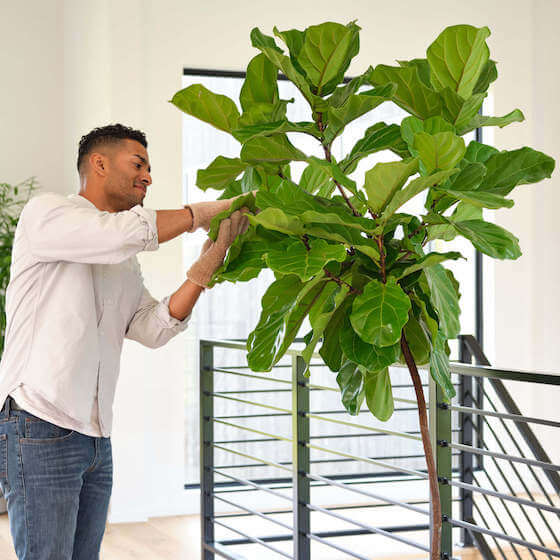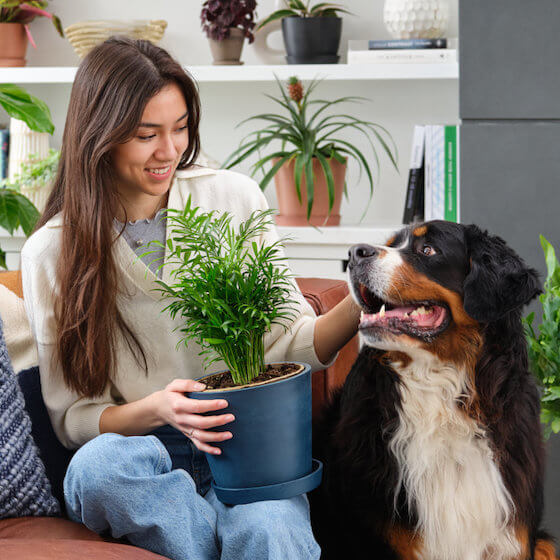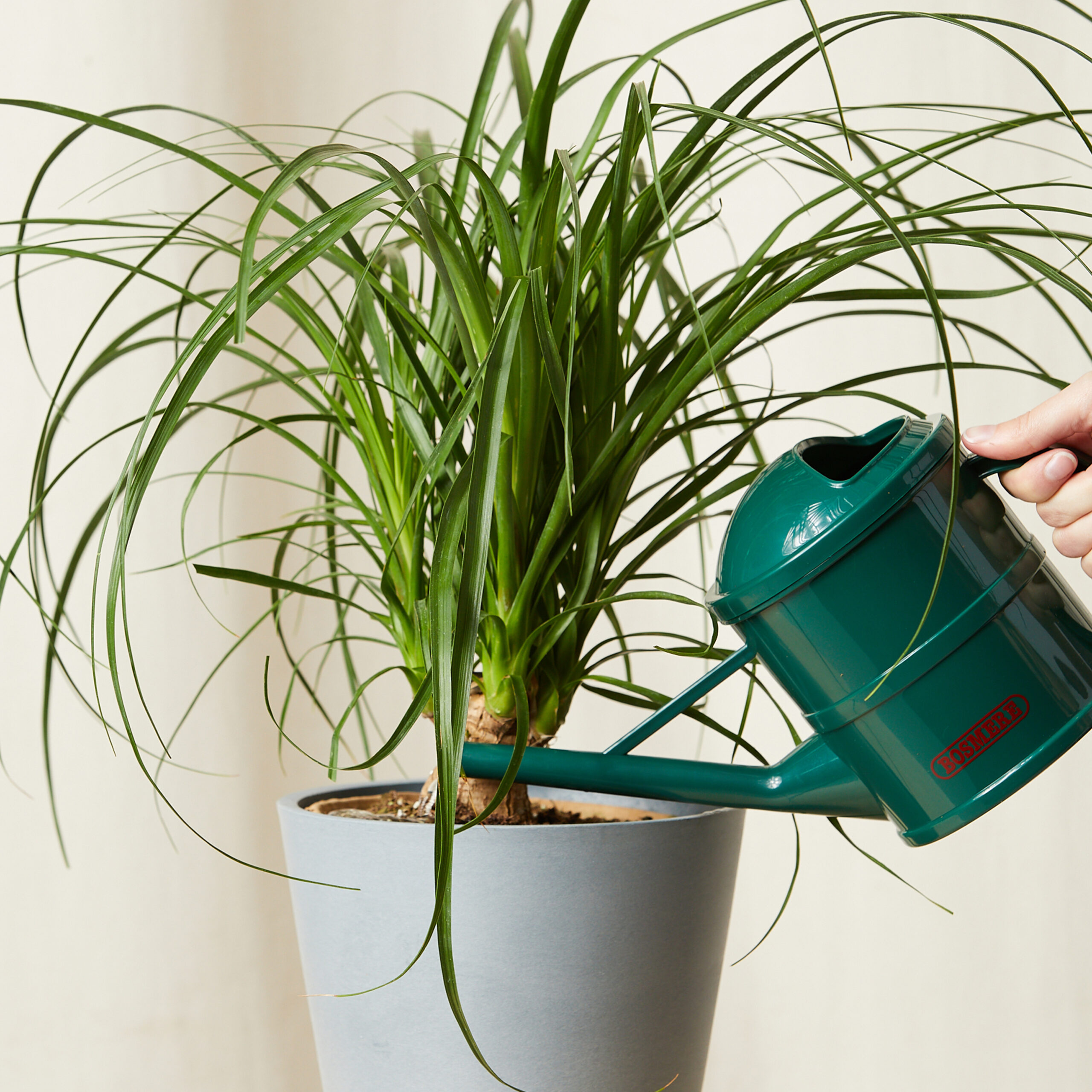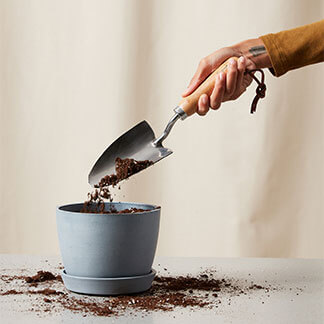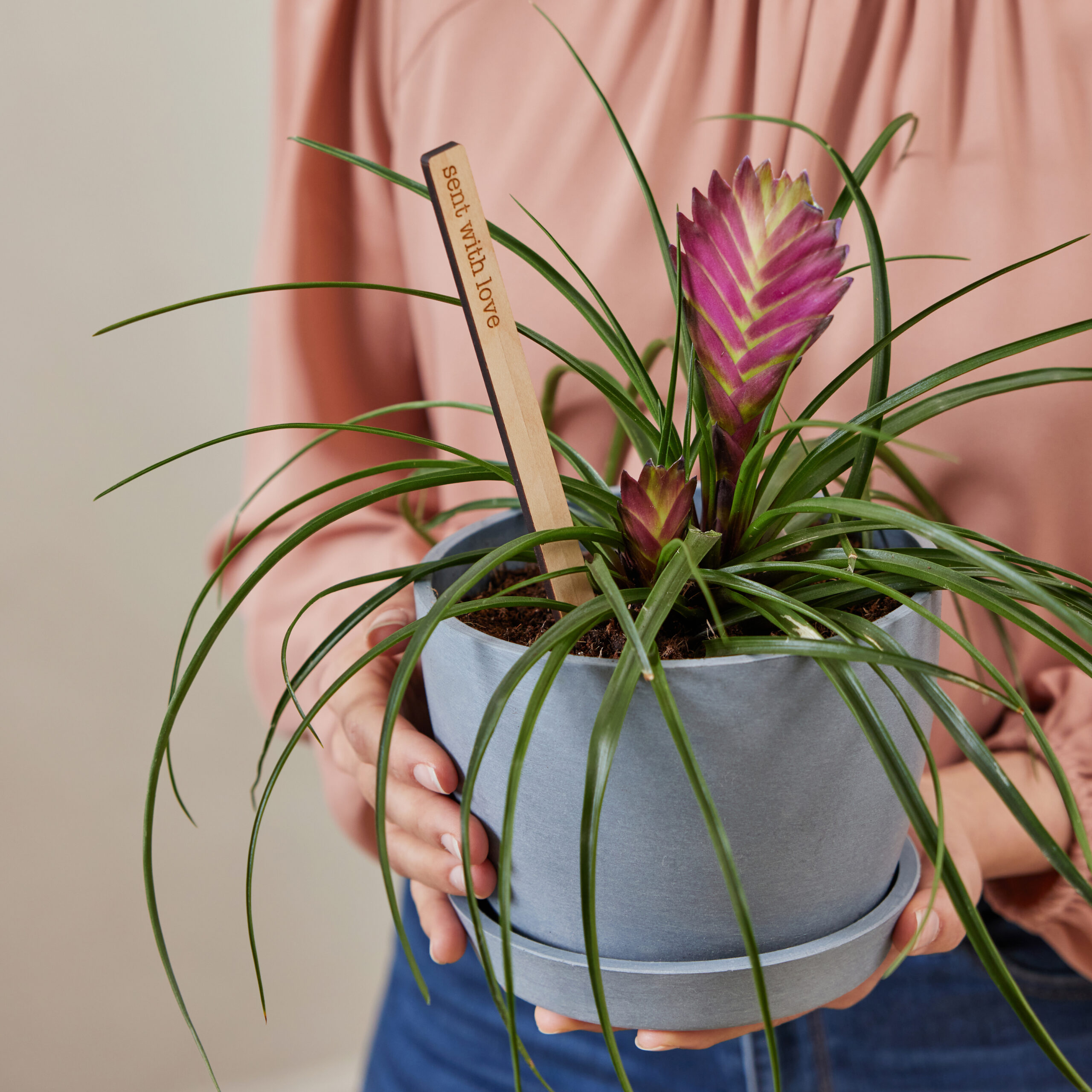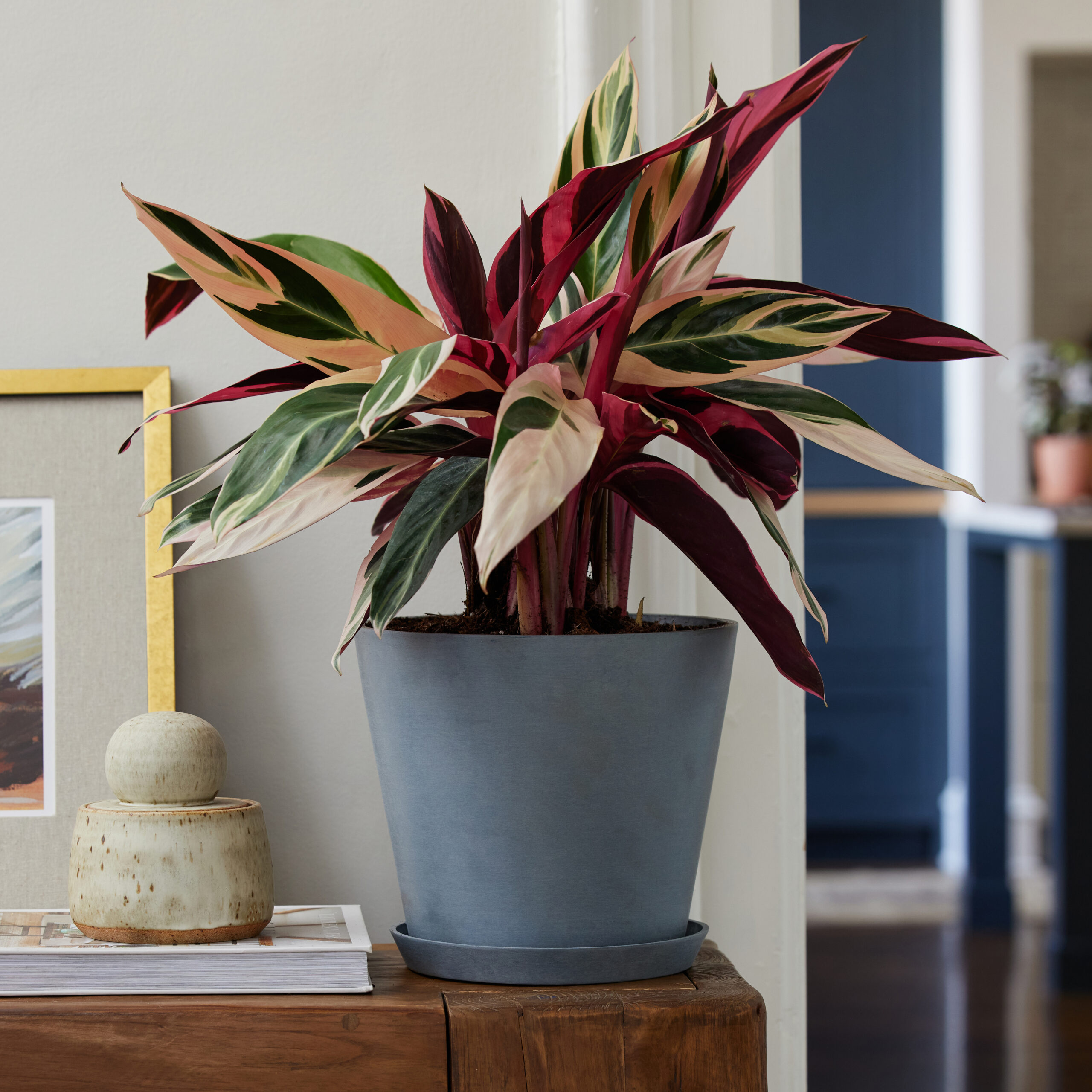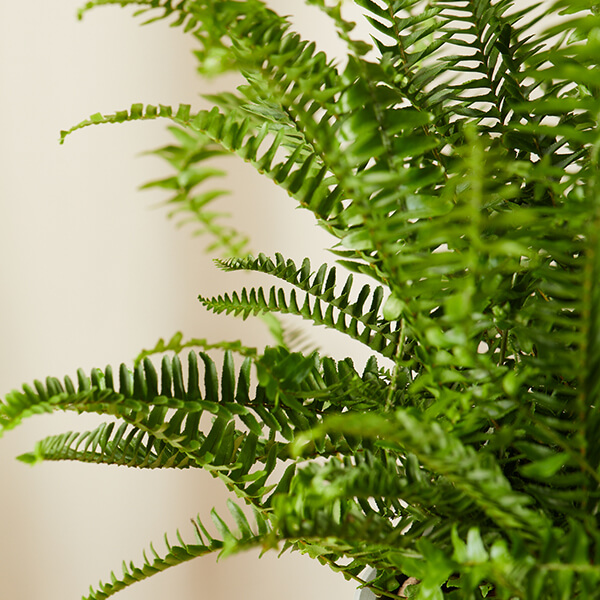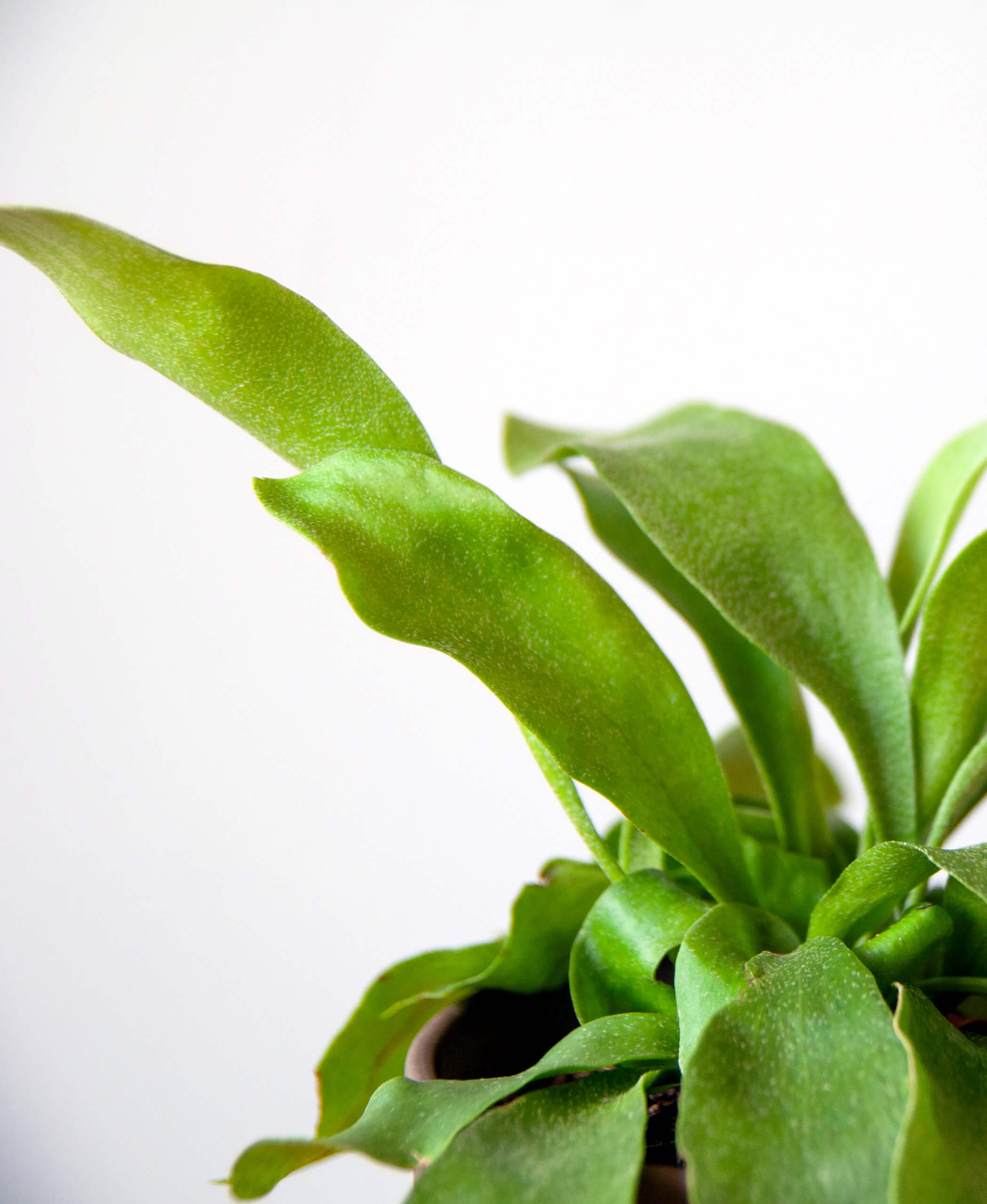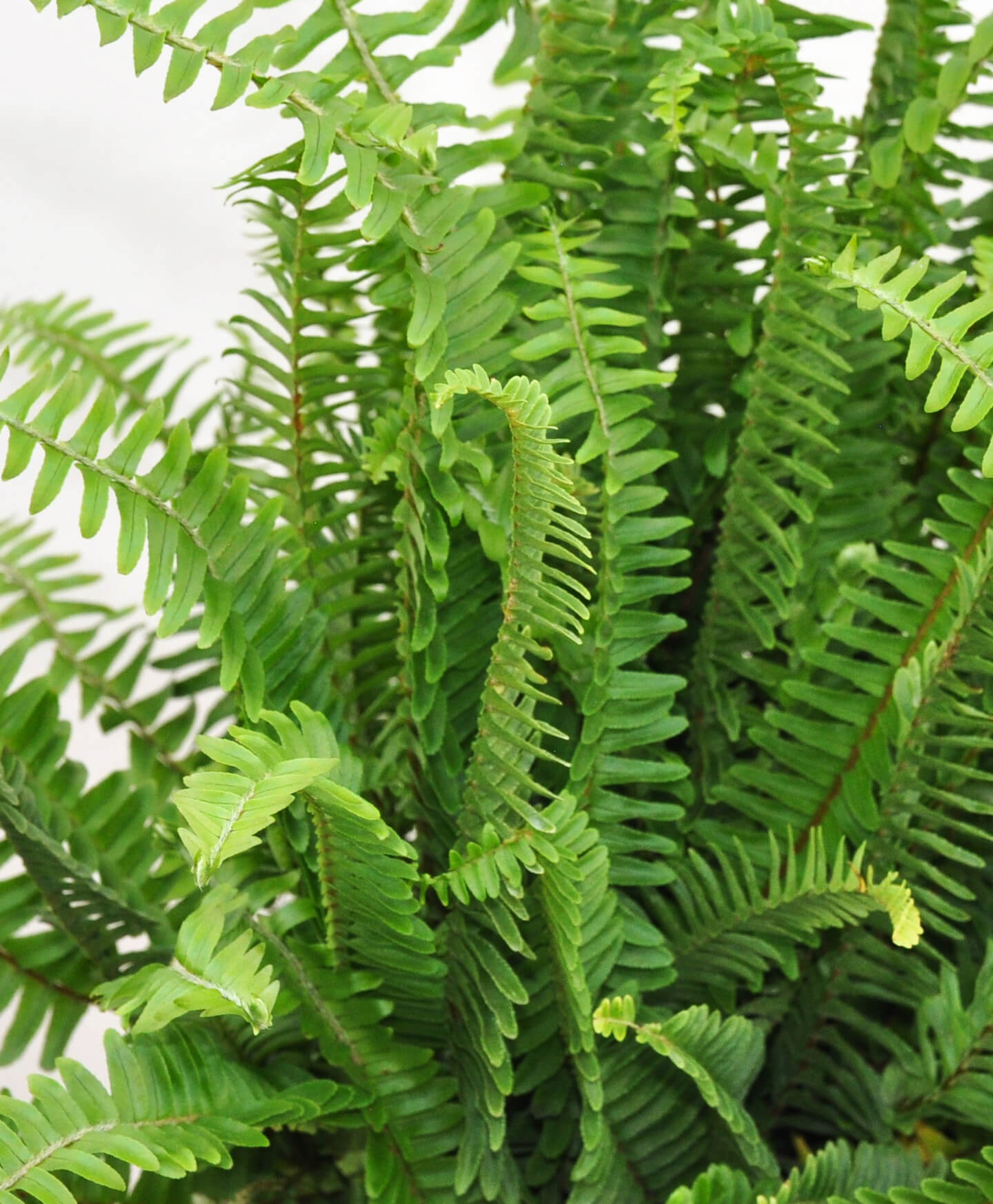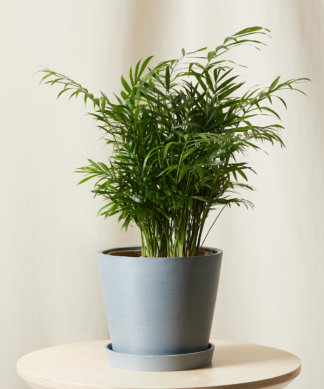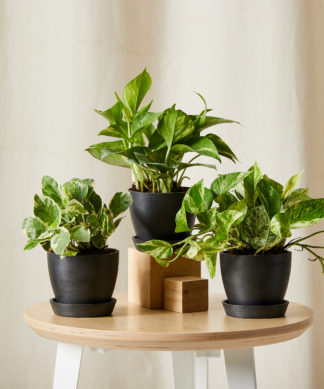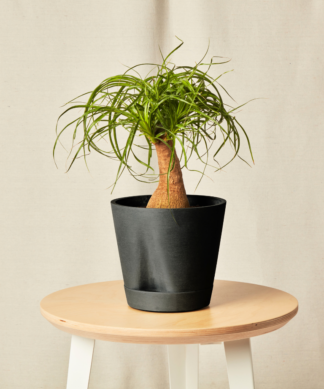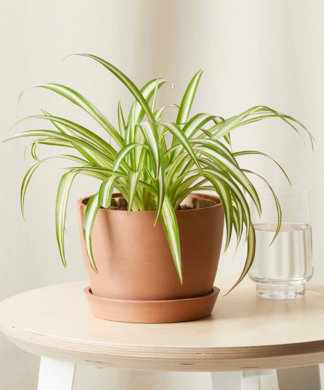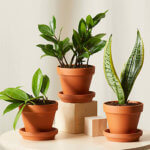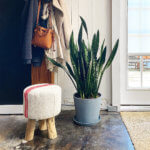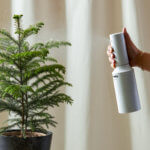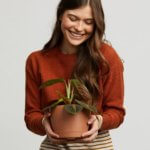How to care for your Fern
Use these instructions to care for a Fern. This guide will tell you how to water a Fern; its light, temperature, humidity preferences and any additional care it might need to help it grow.
Autumn Fern
Your Autumn Fern thrives in bright indirect light. Too much direct light will burn the foliage, and too little light will cause its signature autumnal colors to fade. If your space doesn’t have adequate lighting, you can supplement with a grow light.
Your Fern grows well when watered regularly. However, you’ll need to water your plant slowly while gradually moistening the soil. Be careful not overwater your Fern. Also allow the top inch of the soil to dry in between waterings, but avoid letting the soil dry out completely since this will stress your plant.
Your Autumn Fern loves a warm, humid environment. If the air in your home is dry, use a pebble tray or place a humidifier nearby. Occasionally, you can mist the leaves.
Autumn Fern plants can grow in temperatures between 60-80°F. While they can tolerate temperatures below 60°F, you might avoid fluctuations as well as drafts and heater vents.
Feed your fern once a month or every 6 weeks in the spring and summer with a general-purpose indoor plant fertilizer diluted at half-strength. There’s no need to feed in the fall or winter when the plant goes into a natural resting period.
The Autumn Fern is non-toxic to humans and pets.
As the plant grows, the lower, older fronds will naturally turn brown. Regularly remove any dead fronds from the plant to encourage healthy new growth. Cut stems at the soil line with clean, sharp pruning scissors or plant snips.
Bird's Nest Fern
Your Bird’s Nest Fern will do best in medium to low light. The more light it receives, the more the leaves will crinkle and the less light, the flatter the leaves will be. Keep in mind, too much light or extended periods of direct sunlight will cause the fronds on the fern to get a pale bleached color.
Water when the top 25% of the soil is dry. When watering, water only the soil – not the leaves. Water accumulating in the crown of your plant could lead to bacterial growth and potential leaf rot. Water until liquid flows through the drainage hole at the bottom of the pot and discard any water that has accumulated in the saucer.
This plant likes a humid environment, like a bathroom or kitchen. Mist often.
This fern will enjoy a warm area, preferably between 68-80 degrees, so maintain indoor temperatures above 60 degrees. Avoid cold drafts and sudden temperature changes.
Feed once a month during the spring and summer with a liquid fertilizer for indoor plants.
Bird’s Nest Ferns are non-poisonous plants and safe for humans, dogs and cats.
Regularly remove any dead fronds from the plant to encourage healthy new growth. Cut stems at the soil line with clean, sharp shears.
Button Fern
Your Button Fern will thrive in low to bright indirect light. Take care to avoid direct sun exposure, as it will scorch the foliage.
Water when the top 25% of the soil is dry. Water until liquid flows through the drainage hole at the bottom of the pot and discard any water that has accumulated in the saucer.
Your Button Fern requires an environment with higher humidity, making it the perfect bathroom or kitchen plant. Throughout the dryer times of the year, use a pebble tray, a humidifier, or frequent misting to help boost humidity.
The ideal temperature for your Button Fern is between 60-75 degrees. Avoid cold drafts and direct air from heating and cooling vents.
For best results, use a general-purpose liquid houseplant fertilizer diluted to half the recommended strength once every month during the spring and summer. No need to feed your plant in the winter, when growth naturally slows. Before applying any form of fertilizer, make sure the soil is damp. Never apply to dry soil.
Button Ferns are non-toxic to humans and pets.
Watch for fronds that are yellowing and wilted, these are signs of overwatering. Brown leaf tips are caused by high temperatures (above 80 degrees) or dry air. Trim off any dry leaflets and raise the humidity around your plant.
Crocodile Fern
Your Crocodile Fern will do best in bright indirect to low light. A northern or eastern window provides the best light exposure. Turn the plant once or twice each month to encourage even growth.
Water when the top 25% of the soil is dry. Water until liquid flows through the drainage hole at the bottom of the pot and discard any water that has accumulated in the saucer.
Your Button Fern requires an environment with higher humidity, making it the perfect bathroom or kitchen plant. Throughout the dryer times of the year, use a pebble tray, a humidifier, or frequent misting to help boost humidity. A kitchen or bathroom is an ideal environment for your Crocodile Fern, as these areas are naturally higher in humidity.
This fern will enjoy a warm area, preferably between 68-80 degrees, so maintain indoor temperatures above 60 degrees. Avoid cold drafts and sudden temperature changes.
Use a general houseplant fertilizer diluted to half the recommended strength once a month during spring and summer months. Make sure the soil is thoroughly damp before fertilizing–never apply fertilizer to dry soil.
Crocodile Ferns are non-poisonous plants and safe for humans, dogs, and cats.
Trim off crowded fronds with clean, sharp shears to encourage airflow. This will help reduce the possibility of fungal infections.
East Indian Holly Fern
Your East Indian Holly Fern prefers bright indirect light but will adapt to medium light conditions. Take care to avoid direct sun exposure, as it will scorch the foliage.
Water your East Indian Holly Fern when the top 25% of the soil becomes dry. When watering, thoroughly drench until the water drains into the saucer. Empty the saucer of any standing water so as not to drown the roots. Maintaining the correct soil moisture is key to keeping your East Indian Holly Fern happy and healthy. Keep your East Indian Holly Fern’s soil consistently moist, but not soggy, and avoid allowing your fern to dry out completely.
Your Holly Fern will appreciate added humidity. Kitchens and bathrooms are great spots for your fern. Mist often, place a humidifier nearby or use a pebble tray to boost humidity.
Your East Indian Holly Fern will thrive in normal room temperatures between 60–80 degrees. It can tolerate periods of colder temperatures, but for best results keep it in warmer temperatures.
Feed your fern once a month during the spring to the end of summer with a general houseplant fertilizer diluted to half the recommended strength.
Your East Indian Holly Fern is non-toxic and pet-friendly.
Regularly remove any dead fronds from the plant to encourage healthy new growth. Cut stems at the soil line with clean, sharp shears.
Emina Fern
Emina Ferns will thrive in low to bright indirect light. Take care to avoid direct sun exposure, as it will scorch the foliage.
Water when the top 25% of the soil is dry. Water until liquid flows through the drainage hole at the bottom of the pot and discard any water that has accumulated in the saucer.
Your Emina Fern requires an environment with higher humidity, making it the perfect bathroom or kitchen plant. Throughout the dryer times of the year, use a pebble tray, a humidifier, or frequent misting to help boost humidity.
This beautiful fern does not like being cold and does best when the temperature is between 60-75 degrees. If the temperature falls below 60 degrees, it will stop growing. Avoid cold drafts and sudden temperature changes.
For best results, use a general all-purpose liquid houseplant fertilizer once every month during the spring and summer. Never feed a fern when the soil is dry, it will burn the fronds.
Emina Ferns are non-poisonous to humans and pets.
Regularly remove any dead fronds from the plant to encourage healthy, rich, and green growth. Cut stems at the soil line with clean, sharp shears. If you wish to boost the fern’s vigor and deepen the plant’s color, supplement regular fertilizing once during the spring and again in midsummer with 2 tablespoons of Epsom salts dissolved in a gallon of water.
Footed Blue Star Fern
Your Blue Star Fern prefers bright indirect light but will adapt to lower lighting conditions. It will not tolerate direct sunlight, as the foliage will burn.
Your Blue Star Fern is relatively hardy and will tolerate soil that dries out from time to time, but it prefers its soil to be kept moist–never wet or soggy. Water when 50% of the soil volume has dried out. Always water thoroughly until water flows out of the drainage hole and discard any water left in the saucer.
Your Blue Star Fern will do just fine in average household humidity but will appreciate a boost in humidity through regular misting or adding a humidifier nearby. Your bathroom and kitchen are great spots to keep your Blue Star Fern, as these areas are most humid.
For best results, use a general houseplant fertilizer diluted to half the recommended strength once a month during the spring and summer. Make sure soil is moist before fertilizing. Never apply fertilizer to dry soil.
Your Blue Star Fern will thrive in average room temperatures between 65-80°F. Avoid placing it near forced-air vents or drafty doors and windows.
Your Blue Star Fern is non-toxic and pet-friendly.
Regularly remove any dead fronds from your plant to encourage lush new growth. Cut stems close to the soil line with clean, sharp snips.
Kangaroo Fern
Your Kangaroo Fern prefers bright indirect light, but will adapt to lower lighting conditions. It will not tolerate direct sunlight, as the foliage will burn.
Water when the top 25% of the soil is dry. Water until liquid flows through the drainage hole at the bottom of the pot and discard any water that has accumulated in the saucer. This Fern can tolerate drying out a little, but never all the way.
Your Kangaroo Fern will do just fine in average household humidity, but will appreciate a boost in humidity through regular misting, a pebble tray, or adding a humidifier nearby.
Your Kangaroo Fern will thrive in average room temperatures between 65-80 degrees.
For best results, use a general houseplant fertilizer diluted to half the recommended strength once a month during the spring and summer. Make sure soil is moist before fertilizing. Never apply fertilizer to dry soil.
Your Kangaroo Fern is non-toxic and pet-friendly.
Regularly remove any dead fronds from your plant to encourage healthy, rich, and green growth. Cut stems at the soil line with clean, sharp shears.
Kimberly Queen Fern
Your Kimberly Queen Fern prefers bright, indirect light, but can survive in the direct sun if it’s watered on a regular basis and the soil remains moist.
Water when the top 25% of the soil is dry. Water until liquid flows through the drainage hole at the bottom of the pot and discard any water that has accumulated in the saucer.
Your Fern requires an environment with higher humidity, making it the perfect bathroom or kitchen plant. Throughout the dryer times of the year, use a pebble tray, a humidifier, or frequent misting to help boost humidity.
This beautiful fern does not like to be cold, so it’s best to keep the temperature between 65-80 degrees. If the temperature falls below 60 degrees, it will stop growing.
For best results, use a general houseplant fertilizer at half strength once every three months. Never feed a fern when the soil is dry, it will burn the fronds.
Kimberly Queen Ferns are non-poisonous to humans and pets.
Regularly remove any dead fronds from the plant to encourage healthy, rich, and green growth. Make sure your Kimberly Queen Fern is not in a drafty area in your home or office.
Lemon Button Fern
Your Lemon Button Fern will thrive in medium to bright indirect light. Take care to avoid direct sun exposure, as it will scorch the foliage.
Water when the top 25% of the soil is dry. Water until liquid flows through the drainage hole at the bottom of the pot and discard any water that has accumulated in the saucer.
Your Lemon Button Fern requires an environment with higher humidity, making it the perfect bathroom or kitchen plant. Throughout the dryer times of the year, use a pebble tray, a humidifier, or frequent misting to help boost humidity.
The ideal temperature for your Lemon Button Fern is between 60-75 degrees. Avoid cold drafts and direct air from heating and cooling vents.
Use a general-purpose liquid houseplant fertilizer diluted to half the recommended strength once every month during the spring and summer. No need to feed your plant in the winter, when growth naturally slows. Before applying any form of fertilizer, make sure the soil is damp. Never apply to dry soil.
Lemon Button Ferns are non-toxic to humans and pets.
Watch for fronds that are yellowing and wilted, these are signs of overwatering. Brown leaf tips are caused by high temperatures (above 80 degrees) or dry air. Trim off any dry leaflets and raise the humidity around your plant with regular misting or a pebble tray.
Mahogany Fern
Your Mahogany Fern prefers bright indirect light but will adapt to lower light conditions. Keep out of direct sunlight, as it can burn the foliage.
Water when the top 25% of the soil is dry. Water until liquid flows through the drainage hole at the bottom of the pot and discard any water that has accumulated in the saucer.
The Mahogany Fern will appreciate added humidity. Kitchens and bathrooms are great spots for your fern. Misting often, place a humidifier nearby, or use a pebble tray to boost humidity.
Your Mahogany Fern will thrive in normal room temperatures between 65-80 degrees.
Feed your fern once a month during the spring to end of summer with a general houseplant fertilizer diluted to half the recommended strength.
Your Mahogany Fern is non-toxic and pet-friendly.
Regularly remove any dead fronds from the plant to encourage healthy new growth. Cut stems at the soil line with clean, sharp shears.
Maidenhair Fern
Place your Maidenhair Fern in low to indirect bright light. Too little light and growth will slow, but too much light can burn the foliage.
The Maidenhair Fern does not tolerate dry conditions. Keep the soil moist by watering when 25% of the soil volume is dry. Water thoroughly until you see it flow out of the drainage hole and discard any excess water in the saucer.
Your fern prefers a humid environment. Place a humidifier nearby or use a pebble tray. Kitchens and bathrooms are also great spots for your fern.
Your Maidenhair Fern will thrive in normal room temperatures between 65-80°F. Keep your fern away from blowing air or drafty areas, as it can cause damage to its delicate leaves.
Feed your fern once a month during the spring and summer with a general houseplant fertilizer diluted to half the recommended strength.
The Maidenhair Fern is non-toxic to humans and pets.
It is normal to see occasional leaf browning due to age or if the plant got too dry. Regularly remove any dead fronds from the plant to encourage healthy new growth. Cut stems at the soil line with clean, sharp shears.
Maidenhair Blush Fern
Your Maidenhair Blush Fern prefers bright indirect light but will adapt to medium light conditions. Keep out of direct sunlight, as it can burn the foliage.
Water when the top 25% of the soil is dry. Water until liquid flows through the drainage hole at the bottom of the pot and discard any water that has accumulated in the saucer. This plant will not tolerate drying out.
Your Maidenhair Fern will appreciate added humidity. Kitchens and bathrooms are great spots for your fern. Mist often, place a humidifier nearby, or use a pebble tray to boost humidity.
Your Maidenhair Fern will thrive in normal room temperatures between 65-80 degrees. Keep your Fern away from blowing air or drafty areas, as it can cause damage to its delicate leaves.
Feed your fern once a month during the spring to end of summer with a general houseplant fertilizer diluted to half the recommended strength.
Your Maidenhair Fern is non-toxic and pet-friendly.
As this plant is rather particular with humidity, it is normal to see occasional leaf browning. Regularly remove any dead fronds from the plant to encourage healthy new growth. Cut stems at the soil line with clean, sharp shears.
Maidenhair Oceanspray Fern
Your Maidenhair Fern prefers bright indirect light but will adapt to medium light conditions. Keep out of direct sunlight, as it can burn the foliage.
Water when the top 25% of the soil is dry. Water until liquid flows through the drainage hole at the bottom of the pot and discard any water that has accumulated in the saucer. This plant will not tolerate drying out.
Your Maidenhair Fern will appreciate added humidity. Kitchens and bathrooms are great spots for your fern. Mist often, place a humidifier nearby or use a pebble tray to boost humidity.
Your Maidenhair Fern will thrive in normal room temperatures between 65-80 degrees. Keep your Fern away from blowing air or drafty areas, as it can cause damage to its delicate leaves.
Feed your fern once a month during the spring to end of summer with a general houseplant fertilizer diluted to half the recommended strength.
Your Maidenhair Fern is non-toxic and pet-friendly.
As this plant is rather particular with humidity, it is normal to see occasional leaf browning. Regularly remove any dead fronds from the plant to encourage healthy new growth. Cut stems at the soil line with clean, sharp shears.
Rabbit Foot Fern
Place your Rabbit Foot Fern in low to indirect bright light. Too little light and growth with slow, but too much light can burn the foliage.
Water when 50% of the soil volume is dry. Water thoroughly until it flows out of the drainage hole. Discard any excess water in the saucer to avoid root rot.
Your fern does fine in average household humidity, but won’t mind added humidity if leaves begin to crisp.
Prefers temperatures between 60-75°F.
Fertilize once a month during the growing season with a well-balanced fertilizer. No fertilizer is needed during dormancy.
The Rabbit Foot Fern is non-toxic to humans and pets.
You can propagate your Rabbit Foot Fern by cutting off a 1-2” section of fuzzy rhizome, preferably one with a frond or two. Place the cutting in a pot with a peat-based soil mix or sphagnum moss. Keep the growing medium moist and place in a warm humid spot.
Silver Lace Fern
Your Silver Lace Fern will thrive in medium to bright indirect light. Avoid direct sunlight–it will scorch the leaves.
Water when the top 25% of the soil is dry. Water until liquid flows through the drainage hole at the bottom of the pot and discard any water that has accumulated in the saucer.
The Silver Lace Fern will appreciate a bit of extra humidity. Mist frequently, place a humidifier nearby or use a pebble tray to increase humidity levels.
The ideal room temperature for your Silver Lace Fern is between 55-75 degrees. If the temperature falls below 55 degrees, it will stop growing. Avoid drafts and direct air from heating and cooling vents.
Use a general-purpose liquid houseplant fertilizer diluted to half strength once every month during the spring and summer. No need to feed your plant in the winter, when growth naturally slows. Before applying any form of fertilizer, make sure the soil is damp. Never apply fertilizer to dry soil.
Silver Lace Ferns are non-toxic to humans and pets.
For best results, water with filtered water. If you don’t have a filtration system, let tap water sit overnight to evaporate any harsh chemicals and then use the next day or use rainwater.
Silver Lady Fern
Your fern prefers bright indirect light. Avoid direct sunlight, which can scorch the foliage, or too little light which causes slow growth.
Your fern prefers its soil to be kept moist–never wet or soggy. Water when 25% of the soil volume has dried out. Always water thoroughly until water flows out of the drainage hole and discard any water left in the saucer.
Your fern will do just fine in average household humidity, but crispy brown tips can indicate the humidity is too low. In this case, add a pebble tray or place a humidifier nearby.
Your fern will thrive in average room temperatures between 60-80°F. Avoid placing it near forced-air vents or drafty doors and windows.
For best results, use a general houseplant fertilizer diluted to half the recommended strength once a month during the spring and summer. Never apply fertilizer to dry soil; make sure the soil is moist before fertilizing.
Your fern is non-toxic and pet-friendly.
Regularly remove any dead fronds from your plant to encourage lush new growth. Cut stems close to the soil line with clean, sharp snips.
Silver Ribbon Fern
The Silver Ribbon Fern thrives in medium to bright indirect light. Avoid direct sunlight, as it will scorch the leaves.
Water when the top 25% of the soil is dry. Water until liquid flows through the drainage hole at the bottom of the pot and discard any water that has accumulated in the saucer.
The Silver Ribbon Fern will appreciate a bit of extra humidity. Throughout the dryer times of the year, use a pebble tray, place a humidifier nearby or mist often.
The ideal temperature for your Silver Ribbon Fern is between 55-75 degrees. If the temperature falls below 55 degrees, it will stop growing. Avoid drafts and direct air from heating and cooling vents.
Use a general-purpose liquid houseplant fertilizer at half the recommended strength once every month during the spring and summer. There is no need to feed your plant in the winter, when growth naturally slows. Before applying any form of fertilizer make sure the soil is damp–never apply to dry soil.
Silver Ribbon Ferns are non-toxic to humans and pets.
With a sharp pair of scissors or pruning shears, trim off the older, outer fronds of Silver Ribbon Fern if they become shabby-looking. This makes room for new fronds ready to unfurl from the many growing points on the rhizome.
Staghorn Fern
Your Staghorn Fern will thrive in medium to bright indirectlight. It will not do well in low light situations.
Water when the top 25% of the soil is dry. Water until liquid flows through the drainage hole at the bottom of the pot and discard any water that has accumulated in the saucer.
Your Staghorn Fern absorbs water through its fronds as well as its roots. This means that they respond well to misting and appreciate extra humidity. Throughout the dryer times of the year, use a pebble tray to increase humidity place a humidifier nearby, or mist regularly.
The ideal temperature for your Staghorn Fern is between 50-85 degrees. Avoid cold drafts and direct air from a heating and cooling vents.
Use a general-purpose liquid houseplant fertilizer once every month during the spring and summer. No need to feed your plant in the winter, when growth naturally slows. Before applying any form of fertilizer, make sure the soil is damp. Never apply fertilizer to dry soil.
Staghorn Ferns are non-toxic to humans and pets.
Regularly remove any dead fronds from the plant to encourage healthy new growth. Cut stems at the soil line with clean, sharp shears.
